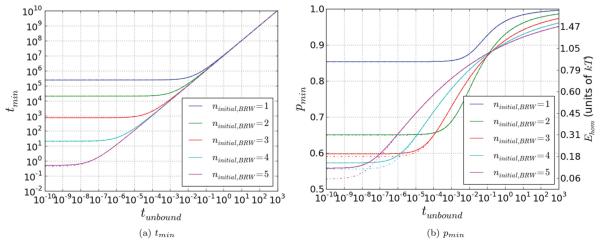FIG. 6.
(Color) Optimized search. In (a), we obtain the minimal values of ttot as a function of tunbound, by minimizing the curves shown in Fig. 5. The lines from top to bottom are for ninitial,BRW = 1 through 5, respectively. As expected, for low values of tunbound, the difference in time is quite pronounced, with higher ninitial,BRW leading to faster execution. However, as tunbound is increased, the difference between the various curves becomes less and less pronounced. In (b), we plot the corresponding minimizing values of phom, and the respective values for Ehom, as a function of tunbound. In all cases, increasing tunbound forces higher values of p, because of the increased incentive for higher rH. For the same reason, all values for pmin approach 1 as tunbound becomes very large. For low values of tunbound, the curves also approach constant values. In this regime, the optimal p is determined by the trade-off between 1/rH and thet, without any influence by tunbound. The curves were calculated using an absorbing boundary at nstep,BRW = 10,30,40. They are given by the dash-dotted, solid, and dashed lines, respectively. Note that the differences are very small, and especially between nstep,BRW = 30 and 40 are unnoticeable.

